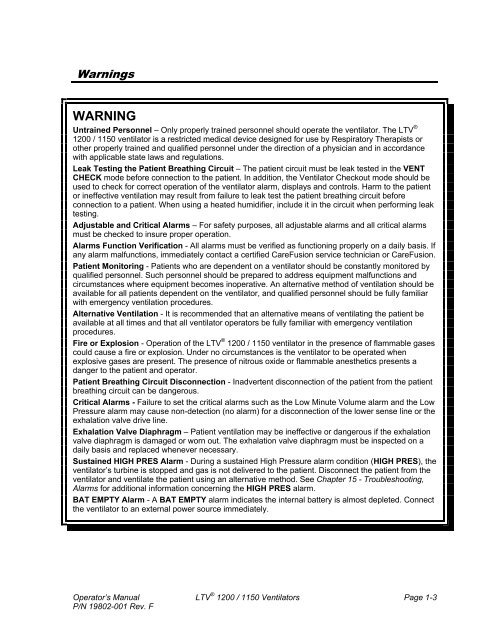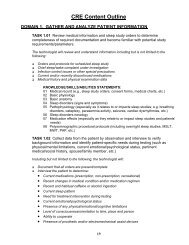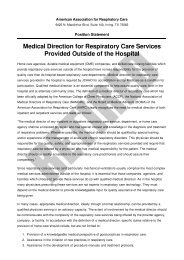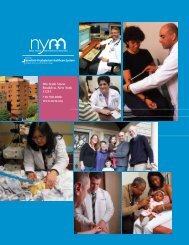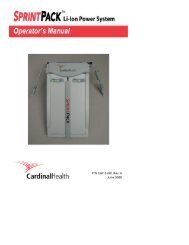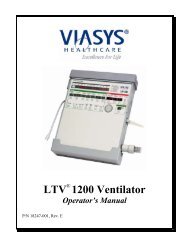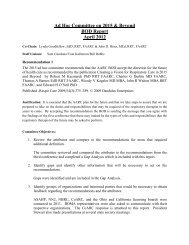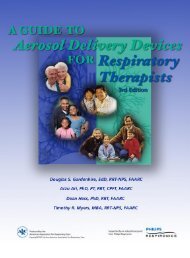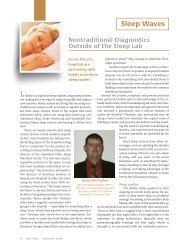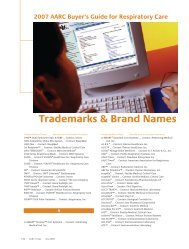LTV 1200 Operator's Manual - AARC.org
LTV 1200 Operator's Manual - AARC.org
LTV 1200 Operator's Manual - AARC.org
Create successful ePaper yourself
Turn your PDF publications into a flip-book with our unique Google optimized e-Paper software.
Warnings<br />
WARNING<br />
Untrained Personnel – Only properly trained personnel should operate the ventilator. The <strong>LTV</strong> ®<br />
<strong>1200</strong> / 1150 ventilator is a restricted medical device designed for use by Respiratory Therapists or<br />
other properly trained and qualified personnel under the direction of a physician and in accordance<br />
with applicable state laws and regulations.<br />
Leak Testing the Patient Breathing Circuit – The patient circuit must be leak tested in the VENT<br />
CHECK mode before connection to the patient. In addition, the Ventilator Checkout mode should be<br />
used to check for correct operation of the ventilator alarm, displays and controls. Harm to the patient<br />
or ineffective ventilation may result from failure to leak test the patient breathing circuit before<br />
connection to a patient. When using a heated humidifier, include it in the circuit when performing leak<br />
testing.<br />
Adjustable and Critical Alarms – For safety purposes, all adjustable alarms and all critical alarms<br />
must be checked to insure proper operation.<br />
Alarms Function Verification - All alarms must be verified as functioning properly on a daily basis. If<br />
any alarm malfunctions, immediately contact a certified CareFusion service technician or CareFusion.<br />
Patient Monitoring - Patients who are dependent on a ventilator should be constantly monitored by<br />
qualified personnel. Such personnel should be prepared to address equipment malfunctions and<br />
circumstances where equipment becomes inoperative. An alternative method of ventilation should be<br />
available for all patients dependent on the ventilator, and qualified personnel should be fully familiar<br />
with emergency ventilation procedures.<br />
Alternative Ventilation - It is recommended that an alternative means of ventilating the patient be<br />
available at all times and that all ventilator operators be fully familiar with emergency ventilation<br />
procedures.<br />
Fire or Explosion - Operation of the <strong>LTV</strong> ® <strong>1200</strong> / 1150 ventilator in the presence of flammable gases<br />
could cause a fire or explosion. Under no circumstances is the ventilator to be operated when<br />
explosive gases are present. The presence of nitrous oxide or flammable anesthetics presents a<br />
danger to the patient and operator.<br />
Patient Breathing Circuit Disconnection - Inadvertent disconnection of the patient from the patient<br />
breathing circuit can be dangerous.<br />
Critical Alarms - Failure to set the critical alarms such as the Low Minute Volume alarm and the Low<br />
Pressure alarm may cause non-detection (no alarm) for a disconnection of the lower sense line or the<br />
exhalation valve drive line.<br />
Exhalation Valve Diaphragm – Patient ventilation may be ineffective or dangerous if the exhalation<br />
valve diaphragm is damaged or worn out. The exhalation valve diaphragm must be inspected on a<br />
daily basis and replaced whenever necessary.<br />
Sustained HIGH PRES Alarm - During a sustained High Pressure alarm condition (HIGH PRES), the<br />
ventilator’s turbine is stopped and gas is not delivered to the patient. Disconnect the patient from the<br />
ventilator and ventilate the patient using an alternative method. See Chapter 15 - Troubleshooting,<br />
Alarms for additional information concerning the HIGH PRES alarm.<br />
BAT EMPTY Alarm - A BAT EMPTY alarm indicates the internal battery is almost depleted. Connect<br />
the ventilator to an external power source immediately.<br />
Operator’s <strong>Manual</strong> <strong>LTV</strong> ® <strong>1200</strong> / 1150 Ventilators Page 1-3<br />
P/N 19802-001 Rev. F


